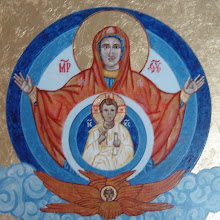St. Ethelbert, King of Kent, 6th century
Icon written by Monk Aidan of Shropshire, Hermitage of Sts. Anthony and Cuthbert
Today we remember St. Ethelbert, King of Kent. In 597, Pope Gregory the Great sent St. Augustine (of Canterbury, not to be confused with St. Augustine of Hippo) with a delegation of Benedictine monks to convert the pagans in Kent. They were received by the King's Christian wife, St. Bertha, and some years later, St. Ethelbert was baptized. He gave land to the monks to build a monastery, and allowed them to freely preach and establish churches.

We also remember St. Tarasius, the Patriarch of Constantinople from 784-806. He was a defender of icons and a preserver of Church unity. He presided over the Seventh Ecumenical Council, where the veneration of icons was confirmed. The iconoclasts who accepted the decision of the Council were received again into the Church. The Council proclaimed:
We define that the holy icons, whether in color, mosaic, or some other material, should be exhibited in the holy churches of God, on the sacred vessels and liturgical vestments, on the walls, furnishings, and in houses and along the roads, namely the icons of our Lord God and Savior Jesus Christ, that of our Lady the Theotokos, those of the venerable angels and those of all saintly people. Whenever these representations are contemplated, they will cause those who look at them to commemorate and love their prototype. We define also that they should be kissed and that they are an object of veneration and honor (timitiki proskynisis), but not of real worship (latreia), which is reserved for Him Who is the subject of our faith and is proper for the divine nature, ... which is in effect transmitted to the prototype; he who venerates the icon, venerated in it the reality for which it stands.




No comments:
Post a Comment